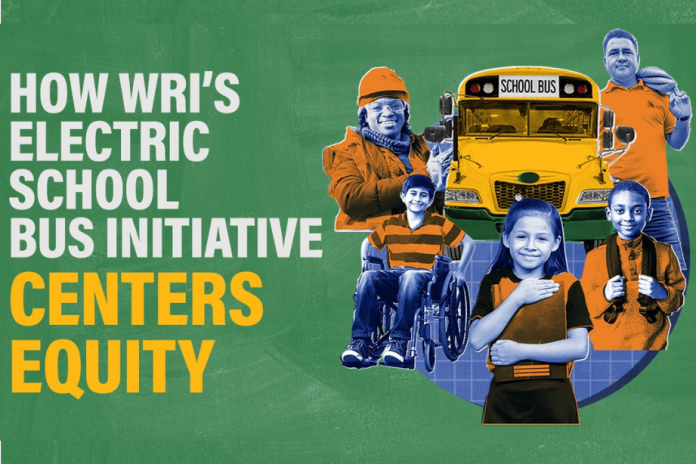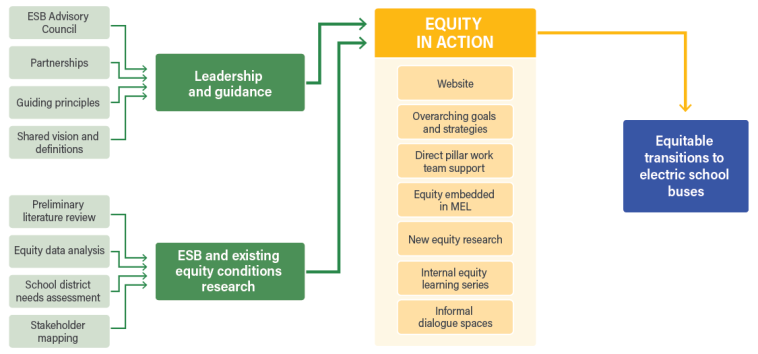How the ESB Initiative Centers Equity
Learn how WRI’s Electric School Bus Initiative works to center equity.

The Equity Framework to Guide the Electric School Bus Initiative
The Electric School Bus Initiative is committed to an equitable transition to electric school buses (ESBs). We believe the communities most impacted by diesel exhaust pollution should have access to the benefits of electric school buses first — and that members of those communities should be engaged throughout the transition process.
But given the long, structural history of racism and discrimination in the U.S., electric school bus advocates can’t just sit back and hope the transition meets the needs of underserved and environmental justice communities. A targeted and proactive approach to equity must be created to ensure communities of color and underserved student populations and their families – who already face disproportionate, negative impacts under the current school transport system – benefit from the ESB transition.
WRI is new to prioritizing equity in our project design and still learning best practice. Because of this, to achieve our goal, WRI’s Electric School Bus Initiative has committed to centering equity and developing an equity framework to outline the approach project staff will use to achieve our equity objectives. The Equity Framework to Guide the Electric School Bus Initiative defines parameters and principles that enable ESB Initiative staff to navigate the complex territory of equity challenges and develop the capacity to engage in purposeful action for equity. It outlines why equity matters to the ESB transition and provides the foundation for transforming our equity goals and principles into concrete actions.
Creating the Equity Framework
To create and translate our goal into an integrated and implementable framework, the ESB Initiative equity team hosted a retreat and conducted an extensive literature review on a range of equity concepts, terms, and projects related to environmental justice, mobility justice, just transitions and historic inequities in the United States. We created recommendations for terminology and shared early drafts with key stakeholders and partners to ensure that our approach aligned with their perceptions and concerns. We also worked with a select number of ESB Initiative Advisory Council members to draft guiding principles. The Council is a diverse and multidisciplinary group of leaders from around the country who provide high-level input on the overall projects. The principles are as follows:
- address historical and structural injustices.
- build trust, listen, learn, and adapt.
- be transparent, accountable, and collaborative; and
- prioritize people over vehicles, profit, property, or placemaking.
The retreat outcomes included agreement that our project overarching equity vision would be to “lead with equity and center intersectionality.” This means the ESB Initiative is committed to:
- Ensuring all activities and possible outcomes consider equity and help address the racial, cultural, educational, safety and health, and economic disparities impacted by or relevant to school bus transport.
- Supporting the development of transparent and inclusive processes and empowered partnerships where the voices, experiences, and needs of community-based stakeholders and partners are valued and reflected in project decision-making.
- Identifying stakeholders and populations systematically affected by past injustices and/or who could be negatively affected by planned ESB Initiative interventions.
- Using actionable monitoring, evaluation and learning mechanisms that ensure that our own work or outcomes do not perpetuate injustices and that we are accountable to our partners and our vision of equity.
- Considering how equity elements are influenced by different identities including race, income, geography, education, ability, occupation, ethnicity, and language and disaggregating data by these dimensions when relevant.
What is intersectionality?
Originally coined by Kimberlé Crenshaw, a scholar and civil rights advocate, intersectionality is an analytical framework for understanding how aspects of a person’s social and political identities combine to create different modes of discrimination and privilege. Intersectionality identifies multiple factors of advantage and disadvantage that may be both empowering and oppressing.
The Framework in Action
Our team created a number of tools and approaches to provide ESB Initiative staff with the skills and understanding to center equity and translate our equity vision into concrete action steps. The Figure below summarizes how all of these pieces fit together. It showcases how we used the leadership and guidance inputs and preliminary research on ESBs and equity to shape our specific action plan components. With this conceptual framework and action plan in hand, we envision this process will ensure the ESB Initiative contributes to the equitable transition to ESBs across the U.S.

Select elements from the "Equity in Action" section outlined in the Figure above are highlighted below. A full description of each component is provided in the Framework document.
- Incorporating equity into planning and staff development. We have crafted goals and strategies to help staff incorporate equity into concrete activities and outcomes in project team workplans and developed specific monitoring and evaluation equity indicators to track progress. We are providing an equity point of contact – an in-house equity advisor – for each project team to ensure equity is incorporated into each team’s activities. The project organizes both a learning series to bring in outside experts and an informal dialogue space to help staff understand the application of real-world equity experiences.
- Inclusive partnerships. We have created a transparent sub-granting process that ensures our potential partners align with the values of the project and have developed a partner taxonomy to ensure diversity and inform participatory and inclusive engagement and communications plans.
- Research priorities. We have taken on new equity research to better understand the needs of school districts and the experiences and opinion of environmental justice groups, children with disabilities and those who attend schools on Tribal lands. We are also collecting trends on equity and ESB procurement. This new research should be published in the coming year and will be used to inform our equity approach. This information, including forthcoming new research findings, will be presented on our public website, which we hope will become a valuable resource for all interested ESB stakeholders.
Impact of the Framework to Date
We are excited about the progress we have made as a result of this effort to center equity and intend to expand our impact as the project continues. In addition to publishing our framework, other examples of how we used our framework to shape our activities and internal processes include:
- Showcasing how equity intersects with the ESB transition on our website, for example this case study on the efforts of the North Carolina’s Eastern Band of Cherokee Indians to bring ESBs to their lands, or the ways government funding programs are centering equity in granting opportunities.
- Using race, income, and ambient pollution level data to identify and prioritize underserved school districts for technical assistance.
- Creating an advisory committee to host discussions with ESB manufacturers that includes non-profits that work with historically disadvantaged communities around battery recycling programs, consideration of end-of-life vehicle plans, and responsible sourcing from suppliers.
- Ensuring workforce development conversations are centered in the overall discussion and representatives from organizations adjacent to the OEMs are part of the discussion.
- Engaging directly with utilities through a working group in discussions on funding and other resources and recommendations to support their role in equitable charging infrastructure planning and ESB deployment, including rates and tariffs.
- Collaborating with environmental justice leaders and incorporating advice from equity experts to guide our research priorities, state and federal policy recommendations and advocacy and other policy objectives and project processes.
We recognize that our work to center equity is only just beginning. Our goal in sharing our framework is to ensure that key stakeholders interested in the electrification of school buses understand how the ESB Initiative has centered equity in its approach and why equity is important for the ESB transition.
We invite all readers to share feedback, ideas and opportunities to advance equity through joint efforts – to ensure everyone benefits from the ESB transition and has a voice in the process:
- If your organization works on topics related to ESBs and equity, check out our webpage and let us know if you would like to add your organization’s name to the list using this form.
- If you would like to present to our project team on work that overlaps with one of these intersections, contact eleanor.jackson@wri.org to discuss the Let’s Break to Educate internal learning series.
- If you work in one of our focus areas supporting school district technical assistance, federal and state policy, workforce training and supply chain issues or utility and financing, contact ESBinfo@wri.org to discuss opportunities for collaboration.